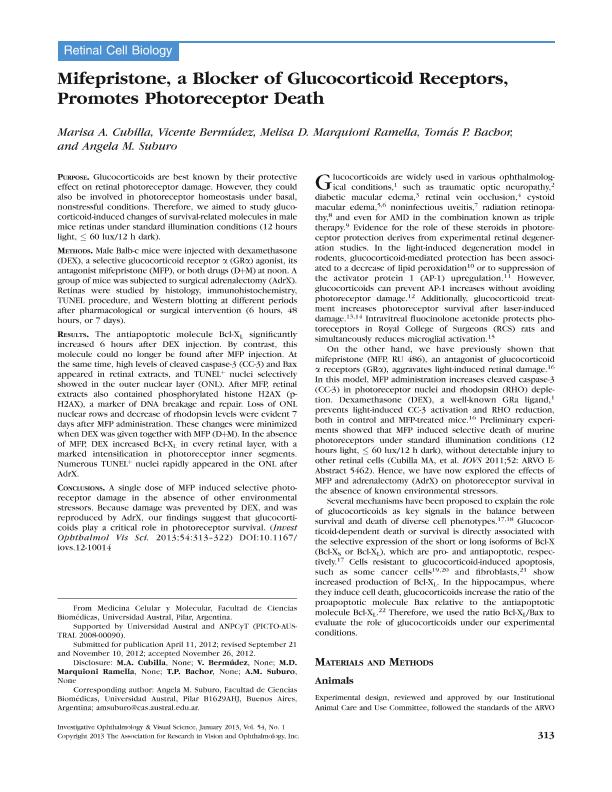Artículo
Mifepristone, a blocker of glucocorticoid receptors, promotes photoreceptor death
Cubilla, Marisa Angélica ; Bermúdez, Vicente
; Bermúdez, Vicente ; Marquioni Ramella, Melisa Daniela
; Marquioni Ramella, Melisa Daniela ; Bachor, Tomás Pedro
; Bachor, Tomás Pedro ; Suburo, Angela Maria
; Suburo, Angela Maria
 ; Bermúdez, Vicente
; Bermúdez, Vicente ; Marquioni Ramella, Melisa Daniela
; Marquioni Ramella, Melisa Daniela ; Bachor, Tomás Pedro
; Bachor, Tomás Pedro ; Suburo, Angela Maria
; Suburo, Angela Maria
Fecha de publicación:
01/2013
Editorial:
Association for Research in Vision and Ophthalmology
Revista:
Investigative Ophthalmology & Visual Science
ISSN:
0146-0404
e-ISSN:
1552-5783
Idioma:
Inglés
Tipo de recurso:
Artículo publicado
Clasificación temática:
Resumen
PURPOSE: Glucocorticoids are best known by their protective effect on retinal photoreceptor damage. However, they could also be involved in photoreceptor homeostasis under basal, nonstressful conditions. Therefore, we aimed to study glucocorticoid-induced changes of survival-related molecules in male mice retinas under standard illumination conditions (12 hours light, ≤ 60 lux/12 h dark). METHODS: Male Balb-c mice were injected with dexamethasone (DEX), a selective glucocorticoid receptor α (GRα) agonist, its antagonist mifepristone (MFP), or both drugs (D+M) at noon. A group of mice was subjected to surgical adrenalectomy (AdrX). Retinas were studied by histology, immunohistochemistry, TUNEL procedure, and Western blotting at different periods after pharmacological or surgical intervention (6 hours, 48 hours, or 7 days). RESULTS: The antiapoptotic molecule Bcl-X(L) significantly increased 6 hours after DEX injection. By contrast, this molecule could no longer be found after MFP injection. At the same time, high levels of cleaved caspase-3 (CC-3) and Bax appeared in retinal extracts, and TUNEL(+) nuclei selectively showed in the outer nuclear layer (ONL). After MFP, retinal extracts also contained phosphorylated histone H2AX (p-H2AX), a marker of DNA breakage and repair. Loss of ONL nuclear rows and decrease of rhodopsin levels were evident 7 days after MFP administration. These changes were minimized when DEX was given together with MFP (D+M). In the absence of MFP, DEX increased Bcl-X(L) in every retinal layer, with a marked intensification in photoreceptor inner segments. Numerous TUNEL(+) nuclei rapidly appeared in the ONL after AdrX. CONCLUSIONS: A single dose of MFP induced selective photoreceptor damage in the absence of other environmental stressors. Because damage was prevented by DEX, and was reproduced by AdrX, our findings suggest that glucocorticoids play a critical role in photoreceptor survival.
Palabras clave:
Retina
,
Mifepristone
,
Glucocorticoids
,
Apoptosis
Archivos asociados
Licencia
Identificadores
Colecciones
Articulos(SEDE CENTRAL)
Articulos de SEDE CENTRAL
Articulos de SEDE CENTRAL
Citación
Cubilla, Marisa Angélica; Bermúdez, Vicente; Marquioni Ramella, Melisa Daniela; Bachor, Tomás Pedro; Suburo, Angela Maria; Mifepristone, a blocker of glucocorticoid receptors, promotes photoreceptor death; Association for Research in Vision and Ophthalmology; Investigative Ophthalmology & Visual Science; 54; 1; 1-2013; 313-322
Compartir
Altmétricas



